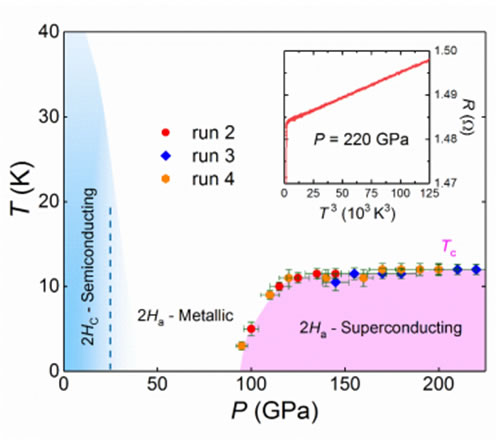A joint research team consisting of the Institute of Solid State Physics of the Chinese Academy of Sciences' Hefei Institute of Materials Science and the Strong Magnetic Field Science Center has made progress in the study of the transition metal dichalcogenide 2H-MoS2 ultrahigh-pressure. The research team used the diamond anvil high voltage generator to measure the superconductivity of 2Ha-MoS2 induced by high pressure through low-temperature electrical transport and synchrotron X-ray diffraction measurements. The density of the superconductivity microscopic view was calculated and explained. Mechanisms, related results are based on "2Ha-MoS2 superconductivity under ultra-high pressure," published in the "Physical Review Express", and was selected as the editorial recommended article.
The transition metal dichalcogenide MX2 (M is a transition metal Ti, Nb, Ta, Mo, W; X is a chalcogen element S, Se, Te) has a layered structure similar to graphite, according to the XMX sandwich monolayer in the unit cell. The number of different MX6 coordination polyhedrons can be divided into 1T, 1T′, Td, 2H and other polymorphs. The ground states of electrons include charge density wave, Mote insulator, exciton insulator, semiconductor, semimetal, metal, and super. Guide and so on. Among them, metal 2H-NbS2, 2H-NbSe2, 2H-TaS2 and 2H-TaSe2 exhibited the behavior of charge density wave and superconductivity coexistence competition under normal pressure. Experimental studies have shown that the charge density wave transformation can be suppressed by chemical intercalation and the application of external pressure, thereby inducing superconductivity in the exciton insulator 1T-TiSe2 and the Mote insulator 1T-TaS2; furthermore, experimental studies have shown that there is no charge density In the outer ear half metal Td-WTe2 of the wave, superconductivity can also be induced by applying external pressure. The charge density wave transition of semiconductor 2Hc-MoS2 was not found under normal pressure. Experimentally, it was confirmed that superconductivity can be induced by chemical intercalation and electrostatic field bias. However, there is no experimental evidence of pressure induced superconductivity.
Based on a self-built high-voltage comprehensive test platform, the research team found that the Ha-MoS2 superconductivity began to appear above 90 GPa, and the critical temperature of superconducting transition Tc was about 3K. As the pressure rises further, Tc increases sharply and reaches about 11K at about 120 GPa. Then, within the pressure range of 130 to 220 GPa, Tc remains unchanged at about 12K. High-voltage synchrotron x-ray diffraction measurements show that 2Ha-MoS2 has no structural phase transition, amorphization, or decomposition in the pressure range of 40-155GPa, indicating that superconductivity is the eigenstate of the 2Ha-MoS2 phase. The density functional calculations found that superconductivity can be attributed to the emergence of new hole-type Fermi pockets induced by high pressure in the 2Ha-MoS2 electronic structure. For the first time in this work, in the 2H structural transition metal dichalcogenide semiconductors with normal charge density waves, superconductivity was observed through pressure control studies, and the pressure-temperature phase diagram of transition metal dichalcogenide systems was enriched.
The research work was supported by the national key R&D program, the National Natural Science Foundation of China, and the Natural Science Foundation of Anhui Province.

Figure 1. Sample placement and electrode layout in a diamond to top anvil.

Fig. 2.2 Pressure-temperature phase diagram of H-MoS2.
Isostatic Graphite Boat,Isostatic Graphite Sheet,Isostatic Graphite Board,Isostatic Graphite Tablets
Henan Carbons New Material Technology Co., Ltd. , https://www.hncarbons.com